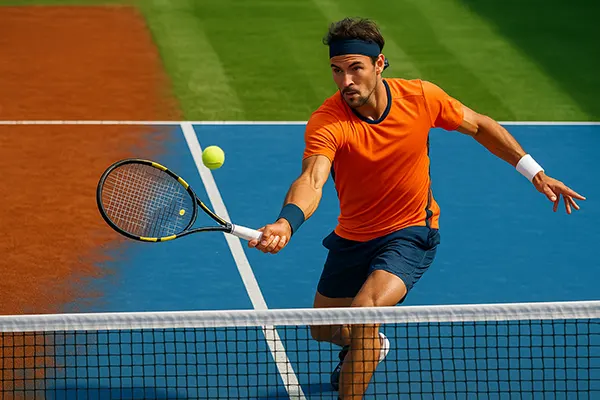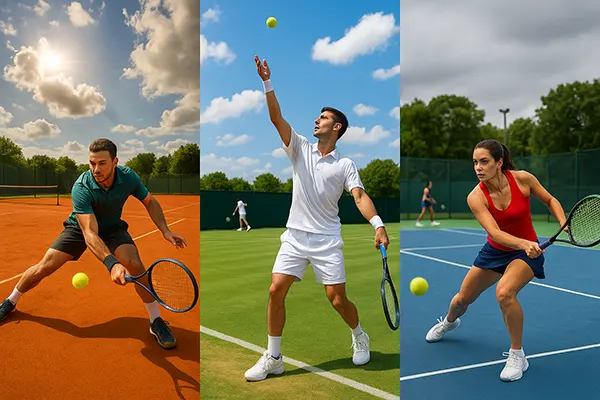
How Climate and Court Surfaces Shape the Playing Styles of Top Tennis Players
Climate conditions and court surfaces have always played a decisive role in shaping how elite tennis players develop their tactics, movement, and overall game strategy. From the slow clay of Paris to the fast grass of Wimbledon, external factors influence not only match outcomes but also the evolution of each player’s unique identity on the court.
Influence of Climate on Physical and Tactical Adaptation
Temperature, humidity, and altitude are among the most significant environmental factors that impact tennis performance. In hot climates, players face challenges with endurance, hydration, and energy conservation. Matches under scorching sun require precise management of effort, leading players to shorten rallies and focus on aggressive play to minimise physical strain.
Conversely, in cooler or high-altitude environments such as Madrid, thinner air increases ball speed, favouring players with strong serves and flat groundstrokes. Adaptation becomes essential—athletes modify string tension, timing, and footwork to maintain control and consistency. Even a few degrees of temperature variation can change ball bounce and shot precision.
Humidity adds another variable, particularly in tropical tournaments like the Miami Open. Heavy air affects ball flight and speed, making topspin shots less effective. Consequently, players must rely on tactical versatility, adjusting their placement and choosing more conservative, percentage-based strategies to handle the slower conditions.
Seasonal Challenges and Player Preparation
The professional tennis calendar exposes athletes to drastically different climates within short intervals. After competing in the heat of Australia, players often transition to the cool, damp European spring for the clay season. This sudden change tests both physical readiness and mental resilience, demanding careful planning from coaches and fitness teams.
Pre-season training frequently includes simulation of extreme conditions using temperature-controlled environments and altitude chambers. Such preparation enhances players’ thermoregulation and stamina, enabling them to sustain peak performance across continents. Nutrition and recovery protocols are also tailored to climate, ensuring hydration and electrolyte balance during long matches.
As climate patterns become increasingly unpredictable due to global warming, tournaments are introducing heat policies and schedule adjustments. These measures aim to protect player health and maintain competitive fairness, demonstrating how environmental awareness has become integral to modern tennis.
Impact of Court Surfaces on Playing Style
Each court type—clay, grass, and hard—presents unique challenges that influence player development and match strategies. Clay courts, like those at Roland-Garros, slow down the ball and produce a higher bounce, rewarding patience, endurance, and heavy topspin. Players such as Rafael Nadal built their dominance on this surface by mastering long rallies and precise shot construction.
Grass courts, in contrast, are fast and favour quick points and serve-and-volley tactics. The low bounce and slippery footing demand sharp reflexes and superior balance. Players like Roger Federer and Novak Djokovic have excelled by blending precision serves with aggressive net approaches while maintaining composure under pressure.
Hard courts, the most common surface, offer a balanced mix of speed and bounce. They reward all-round skills—powerful baseline play combined with strategic defence. The surface’s medium pace allows for diverse playing styles to coexist, which is why tournaments like the US Open and Australian Open often showcase the widest variety of winners.
Surface Transitions and Technical Adjustments
Switching between surfaces requires not only physical adaptation but also subtle changes in technique. On clay, players adopt longer slides and higher follow-throughs to control topspin, whereas on grass they shorten their swings to respond to faster rebounds. Such adjustments demand exceptional body coordination and discipline.
Footwear technology plays a vital role in surface adaptation. Shoe soles differ in texture and grip—clay shoes prevent clogging, grass shoes provide traction through small nubs, and hard-court shoes prioritise cushioning to absorb impact. Choosing the right equipment can make a critical difference in preventing injuries and maintaining stability.
Moreover, mental flexibility complements technical preparation. Successful players learn to read court behaviour quickly, adapting their positioning and shot selection during the first few games. This adaptability often distinguishes champions from the rest of the field in surface transitions.

Case Studies of Top Players and Their Surface Preferences
Rafael Nadal, with his dominance on clay, illustrates how surface mastery can define a career. His heavy topspin forehand and unparalleled stamina were shaped by the slow, demanding nature of clay courts. In contrast, Roger Federer’s elegant efficiency and quick net approaches reflect his affinity for fast grass surfaces.
Novak Djokovic’s success across all surfaces highlights the evolution of a complete player. His flexibility, defensive precision, and mental resilience allow him to transition seamlessly between surfaces, making him a true all-court competitor. This adaptability is often attributed to his rigorous training routines and data-driven coaching.
New-generation players such as Carlos Alcaraz and Jannik Sinner are redefining how young athletes train for surface versatility. Using advanced analytics, biomechanical analysis, and variable-surface practice sessions, they prepare to perform under any conditions—a reflection of how modern tennis increasingly values adaptability over specialisation.
Global Trends and the Future of Tennis Adaptation
The globalisation of tennis has led to a more diverse playing environment, with tournaments hosted in regions featuring extreme climates and unique surfaces. From humid Asian conditions to dry desert events, players now face a broader range of environmental challenges than ever before.
Technological innovation supports this evolution. Smart sensors, wearables, and AI analytics provide real-time feedback on player performance under different conditions. Coaches use this data to optimise training intensity, equipment choices, and hydration strategies, enhancing player resilience.
In the coming years, climate adaptation will likely become a standard part of professional tennis preparation. Sustainability initiatives, improved cooling technologies, and eco-friendly court materials will reshape not only how tennis is played but also how it evolves as a sport committed to both performance and environmental responsibility.
